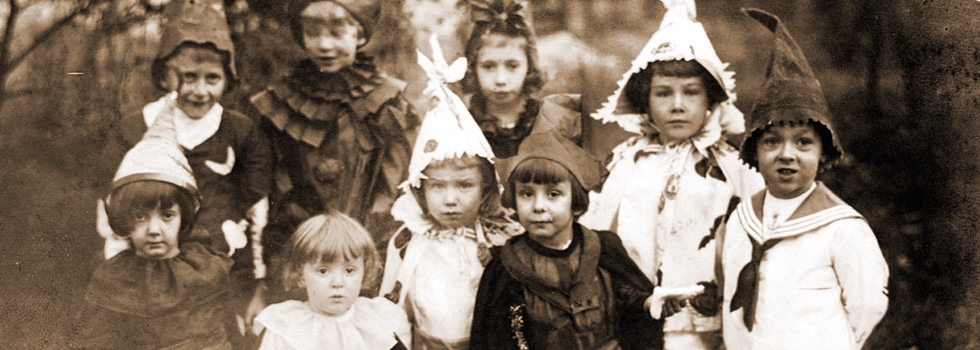How many of us have found boxes of old photographs or family documents stored in the attic or basement? Upon inspection, the photos or papers inside are stuck together, stained or discolored, or crumble when touched. Those irreplaceable records of family history will not survive the adverse conditions of attics and basements, the worst places to store old documents.
Sharp changes in temperature and humidity alternately swell and shrink delicate paper. Dampness permits mold to flourish. Dryness and heat cause brittleness, so that the paper breaks or splits with handling.
You can protect your valuable papers and photos by storing them in an air-conditioned room where temperature and humidity levels are kept fairly uniform. Photographic materials can withstand low temperatures between 40 and 60 degrees F, but problems arise with condensation when items are brought into a warmer area to work with. Additionally, these temperatures are not comfortable for people! Store your photos on the first floor of your house (generally the coolest and most stable in temperature) against an inside wall (temperatures at outside walls can fluctuate).
More important than temperature is relative humidity (RH), a measure of how saturated the air is with moisture. A higher RH of 50 to 100% (meaning more moisture in the air) causes paper to expand and allows rapid mold growth. A lower RH of 0 to 30% stops chemical deterioration processes like the oxidation of silver images but also causes brittleness and shrinkage. Try for a more moderate RH in the region of 30 to 50%.
Paper must also be protected from acidity, which speeds its deterioration. Most paper is naturally acidic, resulting from manufacturing techniques, but it can also absorb acid from its environment (fingers, backing materials, etc.). Paper with a high acid content must be neutralized and alkaline buffered. To recognize acidity in paper, examine the paper in question. If it is discolored, darkened, or has torn edges, it is undoubtedly somewhat acidified. Although conservation of highly acid paper—one that is stained, fragile, or brittle—is best left to a professional, there are steps that the lay person can take to extend the life of his paper items.
Store paper in a treated, protected environment. Whether old papers or photographs are framed or stored in boxes or albums, materials that contact them should be acid-free (neutral pH), lignin-free or alkaline buffered (adding a buffering agent, calcium carbonate). Acid-free paper products of all kinds are available: mat boards, tissue, file folders, and storage boxes. These materials can be ordered from archival supply companies (see below) or can be found in craft stores and camera stores. Non-framed photos or papers should be stored flat in acid-free boxes with a glassine interleaving. Alternatively, each photo or paper can be encapsulated (housed in an inert polyester envelope).
Not all plastic is the same! Plastic enclosures should be made of polyester (polyethylene terephthalate) or polyethylene. Do not use anything made of polyvinyl chloride (PVC). Avoid storing photographs in albums with so-called “magnetic” pages.
After you have rescued your old photos and other documents on paper from your attic and basement, take a closer look at the photographs you live with daily to be sure they are safely displayed and housed. Have old framed photographs rematted and framed using acid-free materials. Use glass to protect the photos from dust, but be sure to leave a space between the glass and the surface of the photo. A metal frame is a prudent choice because it does not emit peroxides and organic vapors as does wood. Do not hang or place photographs in places where they receive direct outdoor light. Ask for UV protective glass (available at framing shops) for framed photographs. Rotate photographs on display so that each one spends some time in dark storage. Or, make copies of your precious photos for display use, then store the originals.
Finally, don’t forget the most obvious conservation measure: wash your hands, which are naturally oily, before handling old papers and photos!
**********************
These companies sell archival materials:
Gaylord Archival Supply – Phone: 800-448-6160, Website: http://www.gaylord.com
Light Impressions – Phone: 800-828-6216, Website: http://www.lightimpressionsdirect.com
To learn more, read:
Curatorial Care of Works of Art on Paper by Anne F. Clapp.
Collection, Use, and Care of Historical Photographs by Robert A. Weinstein and Larry Booth, 1977, American Association for State and Local History, Nashville, Tennessee.
Care and Identification of 19th-Century Photographic Prints by James M. Reilly, 1986, Eastman Kodak Company.

TrackBack URL
https://www.karenfurst.com/blog/how-to-care-for-old-photos-in-your-collection/trackback/